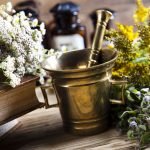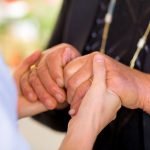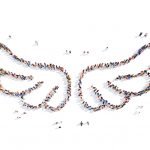The Use of Phrenology in Naturopathy
Sussanna Czeranko, ND, BBE
Feeding the mind is more important than feeding the body.
-E. Purinton, 1911, p. 783The use of phrenology is as multiform as there are people, for Nature never repeats herself, and there are no two just alike.
-Elinor Van Buskirk, 1913, p. 414We are trying to raise better grass, vegetables, fruit and stock. The government is spending millions in experimental stations to produce the best of everything—except what? Why the human, of course.
-J. Sharon 1913, p. 557
http://en.wikipedia.org/wiki/Phrenology
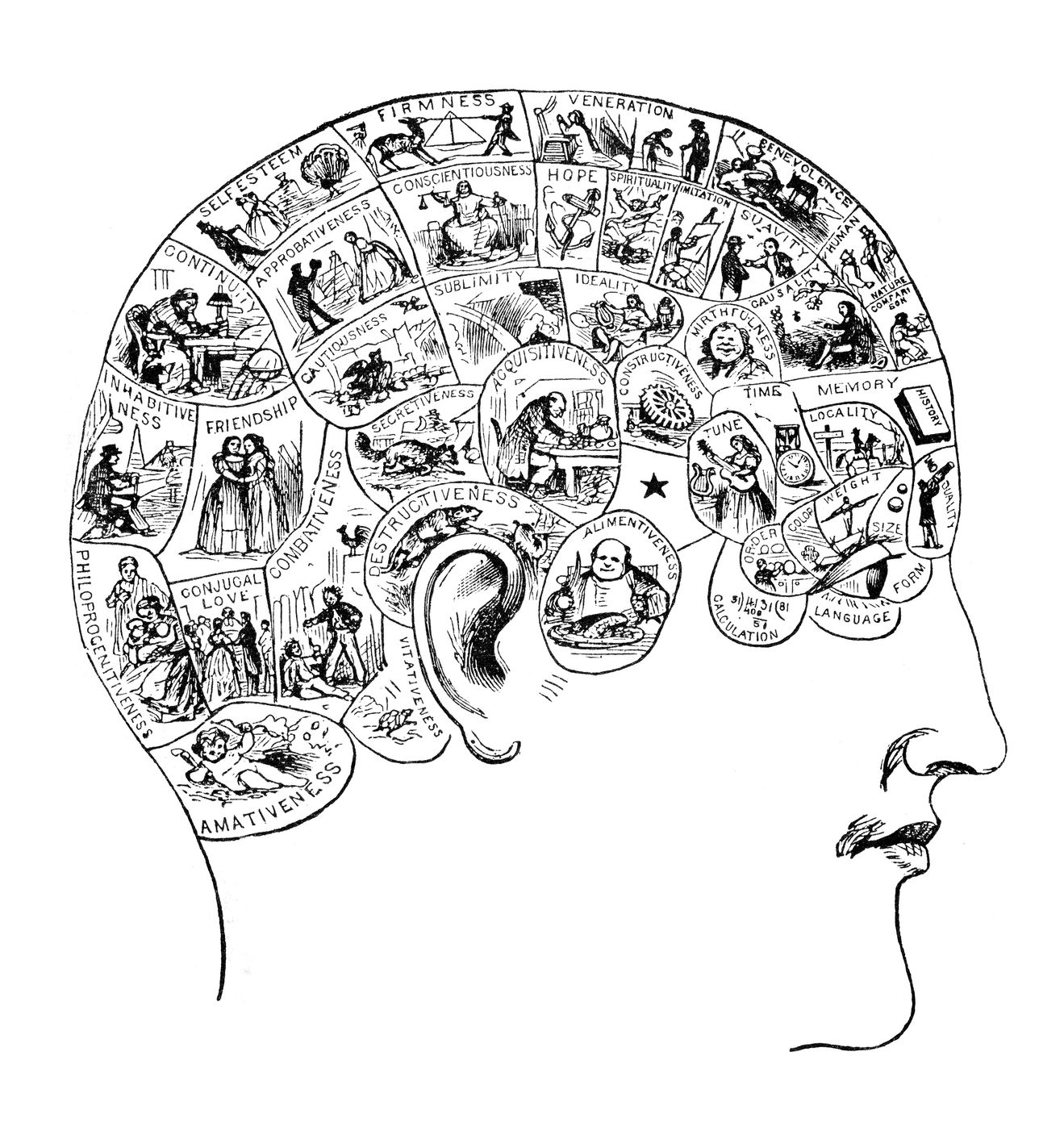
The anatomy and physiology of the brain have been of interest to physicians for a long time. The early NDs pondered the differences between people, not only from the physiological perspective of health promotion but also in terms of personality traits and the individual spirit. Typically, an ND, then and now, might contemplate why two people with the same disease would have such different outcomes. As well, the early ND would wonder why two people with the same living conditions, the same diet, and the same environment might present with different diagnoses? These perplexing questions lead NDs today to keep abreast of new protocols and treatments. The field of phrenology was one direction that many early NDs were drawn to, despite its having been discredited by contemporary physicians.
Phrenology, in fact, laid down the foundations for neuroscience that we take for granted today. Medicine, then as now, focused on the organic structure of the human body to decipher the complexities of disease. Anatomy, physiology, and organic chemistry were the bases for determining the cause or causes of diseases, yet it became apparent that emphasizing the physical components in disease management was not enough to help patients. Van Buskirk, iterating a long-held naturopathic principle that body, mind, and spirit interconnect in heath, reminded early NDs that “[u]ntil the physician realizes that human nature has three aspects instead of one, he will not be of the highest efficiency” (1913, p. 413) in the matter of medical care.
Cromie, as well, advised our early colleagues to have “constantly before our minds high ideals of our physical, intellectual, moral and spiritual natures” (1902, p. 333). The NDs, of course, did embrace body, mind, and spirit in their pursuit of health, as well as a nonsectarian and a noncult idea of serving “mankind in the prevention and cure of physical, spiritual and mental ailments” (Fowler, 1923, p. 638). Part of its attraction, then, was that phrenology and naturopathy shared the belief that the mind was important to the health of people. Lust expounded: “There is no disease, no pain, no worry, [and] no grief that does not originate in mental aberration” (1905, p. 364).
In any case, phrenology in the 19th century was the platform on which psychology would inevitably and soon sit. Phrenology was the early exploration of the brain and the mind: “Phrenology explains the characteristics of men, women and children, as well as the principles that govern the mind” (Fowler, 1911d, p. 815). E. J. Sharon added to that description by pointing out how NDs recognized the following:
[T]he brain is the organ of the mind, and is composed of 43 faculties, and as each organ of the body has its own special location and function, so has each organ of the brain its special location and function. (1913, p. 559)Franz Joseph Gall
Phrenology was founded by Franz Joseph Gall, MD (1758-1828), a German neuroanatomist and physiologist who pioneered the localization of mental functions in the brain. A consummate observer, he studied the anatomy and physiology of the brain. Gross wrote: “[Gall] achieved eminence as a cerebral neuroanatomist: He had distinguished cortical gray and white matter, differentiated projection, association, and commissural fibers, and established the pyramidal decussation” (p. 949).
- A. Fowler reported:
Gall “viewed the brain as an elaborately wired machine for producing behaviour, thought, and emotion and the cerebral cortex as a set of organs with different functions” (Gross, p. 949). Gall took knowledge of the brain to a new realm of understanding.
Student Dr Johann Spurzheim (1776-1832) followed Gall’s work in Germany and France and moved to Boston, Mass., where he introduced phrenology to American physicians. One such person, Lorenzo Niles Fowler (1811-1896), while a medical student at Amherst College, Amherst, Mass., became smitten with this new science from Europe. Very quickly, Elliott reminded us, Lorenzo Fowler established a strong reputation for his work in phrenology: “The name, ‘Fowler’ will always be closely associated with Phrenology” (1911, p. 531) in America in the 19th and early 20th century. Lorenzo Fowler enhanced the work of Dr Gall and Dr Spurzheim by making the original works more practical. He lectured extensively across America and England and with his brother started the American Phrenological Journal in 1838 (Fowler, 1911a, p. 463). Dr J. M. Fitzgerald, a colleague, described Lorenzo Fowler as “one who analyzed the garment of mind back to its simple threads and distinguished each thread as to it quality, consistency and use” (1911, p. 531).
Jessie Allen Fowler, a Woman With a Mission
Jessie Allen Fowler (1856-1932) followed her father’s and mother’s medical footsteps and became a phrenologist, succeeding her father as the editor of the American Phrenological Journal. She sat as the editor of the “Phrenological Section” in The Naturopath and Herald of Health for 3 years (1911-1913). Born in New York, she went to a women’s medical school in London, England, and studied brain dissection. She graduated in 1884 and spent a few years in Australia before returning to the United States in 1896. She was a strong voice for phrenology and worked tirelessly to promote and bring credibility to this new medical movement.
Jessie Fowler and the early phrenologists extrapolated intellect and personality traits from cranial morphology. The shape of heads was the determining variable to explain the differences in the traits or faculties of people. Van Buskirk’s frequent definitions of this new field were widely shared. She described phrenology as follows:
[A] system which teaches that the faculties of the mind are manifested in separate portions of the brain, modified by temperament, the doctrine that the mental powers are . . . measured by cranial diameters and distances from the opening of the ear, and not from “bumps.” (Van Buskirk, 1913, p. 413)Notwithstanding the growth of interest and skill in the emerging field, phrenologists strongly objected to the detractors who would mockingly slur their assessments by characterizing them as searching “for ‘bumps’ when they were examining a head and delineating a character” (Fowler, 1912b, p. 192). Phrenologists were indeed interested in brain size and would determine this by carefully measuring the skull. They “measure[d] the top of the head, from the ears over the superior portion, and from the glabella to the occiput” (McGuire, 1912, p. 476). To determine the size of the frontal lobes, their technique, as described by McGuire, was to draw a line as follows:
[F]rom the anterior superior insertion of the ear to the same point on the other side across the top of the head. . . . The mass of brain which lies between a plane held vertically upwards between the two external auditory mediatuses and another held nearly horizontally from the supercilliary ridges at the eyebrows to meet the first plane. . . . The more vaulted the frontal bone, the more room for the frontal brain. (1912, p. 476)Using this technique, large frontal lobes were attributed to “superior mental powers, intellectual and moral” (McGuire, 1912, p. 476) tendencies. McGuire added: “A large development of the temporal lobes, as shown by great width and depth of the ears indicates great strength of the animal passions and of the physiological force of the constitution” (1912, p. 476).
The phrenologists were not only given to precise measurements. Jessie Fowler, for example, would conduct regular meetings and demonstrate the practical application of phrenology by doing “character readings.” By examining the shape of the face and head features, phrenologists such as Jessie Fowler would attribute certain characteristics.
For example, Hoboken documented the following:
[The] qualities of mind or mental habits are indicated by a face having wide apart zygomatic arch, we would say that in this region of the brain the organs of Alimentiveness, Acquisitiveness, Constructiveness and Tune are located. These faculties give the characteristic traits of economy, constructive power, musical talent, and appetite for food. (1911, p. 817).Faculties and Personality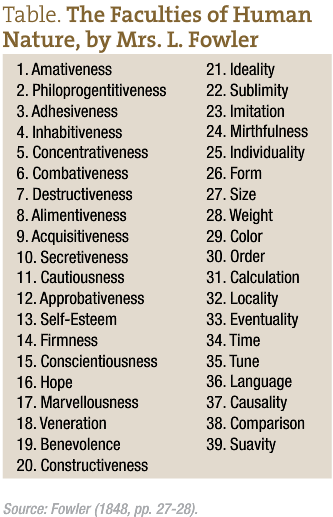
The early phrenologists reasoned that moral sentiments and mental capabilities, when properly guided and controlled, would cultivate the highest state of mind. Those same early phrenologists talked a lot about the “faculties,” which translated into qualities or aspects of personality. Some examples of faculties included benevolence, hope, veneration, consciousness, and spirituality. It was the goal of phrenologists to bring harmony to the faculties of the mind and the body. At the American Institute of Phrenology, the study and description of faculties would translate into a wide range of topics for discussion. One such was “The Will and How to Control It; Memory of Names, and How to Improve It; Concentration and How to Develop It; Executiveness—Its Usefulness in all Kinds of Work” (Fowler, 1912a, p. 125).
Phrenologists believed adamantly that physicians needed to be well versed in the following:
[H]armonious cultivation of the Faculties that constitute the mind; to understand how to be well; how to prevent disease through the Faculty influences of the mind; and how, by the aid of the mind, to augment the successful treatment of disease. (Carriker, 1913, p. 777).Just as with the NDs, it was unthinkable to the phrenologists that one would not consider the mind in medical treatment along with the body. Today, mind-body medicine, as a concept and an approach, has caught the attention of the so-called integrative allopaths. These biomedicine professionals are presumptively invading aspects of naturopathic medicine, the space for which has long been held at great cost by the naturopathic profession. They may not use terminology such as phrenology or temperament in the way that the early NDs did; however, they show increasing interest in the mind-body-spirit continuum. Decades ago, when the medical trust was disparaging such concepts, Lust weighed in on the essential phrenology element of temperament: “[T]he very first factor in naturopathic diagnosis and phrenology is the basis of temperament study” (1905, p. 362).
Temperament, the First Factor in Diagnosis
Considering the temperament of a patient to determine the treatment plan was key to an accurate prescription for many early NDs. If two people with constipation sought allopathic treatment, for example, the orthodox medicine professional of the day would “prescribe cascarets and castor oil and colon flushing” (Lust, 1905, p. 362). However, Lust pointed out that if the two individuals were being assessed phrenologically, the “naturopathic diagnosis distinguishe[d] diametrically. The first sufferer over eats, under exercises and poisons his gastric juices by envy and hate; the second under eats, over studies or over works” (1905, p. 362). The temperaments differ, and thus treatment differs. Phrenology allowed practitioners to determine weaknesses and tendencies. Van Buskirk noted: “[T]hrough physiognomy, the strength or weakness of the internal organs [are apparent] from their corresponding poles in the face. Thus we can read the weak heart or lungs before we use the stethoscope” (1913, p. 414). Many early NDs paid heed to Jessie Fowler about how to use phrenology early on in a person’s life, in childhood where possible, to diagnose and treat effectively, teaching health habits that could endure for a lifetime.
Applied Phrenology Ensures Healthy Children
The practical aspects of phrenology were socially implemented in changing the awareness of presenting conditions in children, which is a serious concern in our era too. In this regard, Jessie Fowler pointed out: “Of 11,000 complaints that were investigated by the society for the Prevention of Cruelty to children, 10,000 proved true” (1911c, p. 742). She insisted that, if phrenology is to be useful, it “must be essentially practical . . . in the future aim at altering the fundamental ideals of parents in the managing and rearing of their children” (Fowler, 1911c, p. 742). The phrenologists advocated that parenting of healthy children could be enhanced with the tools they offered. Sharon advised that parents should study their temperaments “and obey the natural laws of health . . . at least one year before the child is born” (1913, p. 557).
Some parents consulted phrenologists to help with the development of their children. A mother concerned about the temperament of her eldest daughter approached Dr Fitzgerald, president of the American Institute of Phrenology, who gave an account of the appointment:
Upon examination, the eldest daughter possessing very large destructiveness, firmness, self-esteem and secretiveness with exceptionally strong faculties of Amativeness and Causality. She had all of these elements of character very pronounced in her makeup and was very vindictive and even cruel when aroused to anger. (1913, p. 853)
The younger daughter, in contrast, possessed “Benevolence, Ideality, Imitation, perceptive faculties, Friendship, Parental Love and Approbation. She was sympathetic, kind . . . extremely humorous and witty and generous to a fault” (Fitzgerald, 1913, p. 853). Fitzgerald, having not known these children, presented the information to the father, who was a distinguished brain anatomist, who confirmed the analysis to be very accurate. Fitzgerald showed the father the head measurements and his method of observation.
Essentially, according to Burnham, writing at the peak of interest in phrenology, the technique followed a protocol in which, once the head had been examined, “the phrenologist show[ed] the parent how to curb the abnormal instincts and to turn them into other channels where they can have vent and yet be exercised for some definite good” (1912, p. 123). Purinton wrote about how the education and care of children represented a priority concern among phrenologists. He explained:
[T]he tragedy of youth is the hunger for an understanding of its aspirations. . . . When teachers, ministers and parents learn how to feed the minds of children properly, there will be no more dullards . . . no more “black sheep of the family.” (Purinton, 1911, p. 783).Cox, considering “mind culture” and the role of the cognitive development in overall health, felt that one contributing problem lay in how formal education was carried out. He explained that education in the real sense of the word “meant to draw out, in the sense of unfolding, what was by nature at birth infolded, but would judge from present day practice, that it meant to pack in or to cram” (Cox, 1911, p. 317). Commenting on this area of focus, Purinton affirmed the “treachery” of education (by which he referenced public education, in particular) as applied to examinations, the orthodox assessment method for children’s progress in learning and development. He contended: “Memory is mostly at war with originality. Stuff a child’s brain with facts and you leave no room in his mind for ideas. The questions children ask—not the books they quote—are the true educators” (Purinton, 1918, p. 713).
Mind culture embraced the “education of the mind by denials and affirmations so that it is developed into a positive character, radiant and strong with noble thoughts and feelings” (De Voe, 1912, p. 455). Purinton’s advice for the teaching of children was to “teach [children] how to think, to observe, to read, to ponder, to plan, resolve and achieve” (1911, p. 785). The goal of phrenology was to help draw out the natural gifts and faculties that were “the special endowment any particular person was blessed with” (Cox, 1911, p. 318).
Phrenologists, with their “mind charts” and focus on tests to determine vocation, were especially interested in helping people identify their natural endowments, from childhood onward. Humphries had a particular interest in the formative potential of phrenology diagnostics, suggesting that “if each man could select an occupation for which he were better adapted . . . he can serve the world in the best manner” (1913, p. 851). Consulting a phrenologist took the element of uncertainty from the pursuit of a successful livelihood. Jessie Fowler articulated:
[T]he Science of Mind, or the New Phrenology, will tell a person before he makes a start whether he is likely to succeed in his undertaking or not, and therefore he will not have to spend years in testing his ability to see whether he has any real talent or not. (1912c, p. 332)In her view, people “not only desire but deserve a brighter and better career” (Fowler, 1912c, p. 332). Humphries echoed this: “Let us help them find and follow it” (1913, p. 852).
To study phrenology, students could go to New York, to the American Institute of Phrenology, a school operated by Jessie Fowler. There, they would learn about temperaments, the laws of health, and how to study strangers, as well as brain anatomy and dissection (Fowler, 1911b, p. 535). At the commencement of the 1911 phrenology graduates, Jessie Fowler gave the following advice: “Be faithful, be prudent, be courageous, be tactful, and when examining a person consider two points of view: first, one of encouragement; second, one of kindly advice and criticism—one of tearing down and the other of building up” (1911d, p. 814).
Hope for Harmony
D. Larson, another early ND, developed a formula for health that included “harmony of thoughts” and contemplated some of the theoretical and clinical tools of phrenology. His recipe was: “Discord wastes energy, while harmony accumulates energy; therefore, if we wish to be strong in mind and body, and be in the best possible condition for the best possible work, harmony is indispensable” (Larson, 1909, p. 560). In Larson’s view, the importance of harmony in improving our ability to work also leads to self-development. He wrote: “All harmonious work promotes development of mind and body” (Larson, 1909, p. 560). It is not surprising, then, that the contributions of phrenology to the mind-body connection so valued by the early NDs was always in sight for them. Cromie explained: “The physical body is moulded and fashioned by our thoughts and emotions. . . . The mind has the power to keep the body strong and healthy, and to preserve life many years longer than it does now” (1902, p. 331).
The literature includes further suggestions by Larson on how to achieve “mental harmony.” He reminded us that “we must bear in mind that great fact that it is not what happens that disturbs us, but the way we think about that which happens” (Larson, 1909, p. 561). In his view, when we are surrounded by disturbing circumstances, it is up to us to choose to look at another side of the situation and see the “better side, its ideal side, its calm, undisturbed side” (Larson, 1909, p. 561). Cromie reinforced this power of “positive thinking,” as it were. To keep the body strong, one needed to think good thoughts. Cromie wrote: “All discordant thoughts and words have a tendency to weaken and transform our bodies” (1902, p. 332).
The last word goes to E. E. Purinton. Purinton advised that people should wisely apportion their mental activities. He wrote: “[F]or every hour one speaks, he should read two hours, and meditate three hours. . . . Meditation is to the mind what sleep is to the body—the agent of balance and assimilation” (Purinton, 1911, p. 786). Indeed, NDs in all eras know that balance among body, mind, and spirit is a core element of lifelong wellness. The early NDs were constantly in search of tools to promote such harmony and balance, and phrenology was one such tool.
Next month, we will examine how early NDs applied phrenology in their clinical practice.
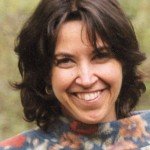 Sussanna Czeranko ND, BBE is a naturopathic physician licensed in Ontario and in Oregon, practicing since 1994. She incorporates “nature-cure” approaches systematically into primary care by including Balneotherapy, Breathing therapy and Nutrition. As the Rare Books Curator at NCNM, Dr Czeranko is currently compiling an eleven volume series titled, In Their Own Words, based upon the Benedict Lust journals published early in the last century. As the founder of the Breathing Academy, a training institute for naturopaths, she facilitates the incorporation of the scientific model of breathing therapy called Buteyko into their practices.
Sussanna Czeranko ND, BBE is a naturopathic physician licensed in Ontario and in Oregon, practicing since 1994. She incorporates “nature-cure” approaches systematically into primary care by including Balneotherapy, Breathing therapy and Nutrition. As the Rare Books Curator at NCNM, Dr Czeranko is currently compiling an eleven volume series titled, In Their Own Words, based upon the Benedict Lust journals published early in the last century. As the founder of the Breathing Academy, a training institute for naturopaths, she facilitates the incorporation of the scientific model of breathing therapy called Buteyko into their practices.
References
Burnham, R. P. (1912). Phrenology: Its practical application in the education of children. The Naturopath and Herald of Health, 17(8), 122-124.
Carriker, M. A. (1913). Every physician should be a phrenologist. The Naturopath and Herald of Health, 18(11), 777-779.
Cox, W. (1911). Phrenology and education. The Naturopath and Herald of Health, 16(5), 317-318.
Cromie, W. J. (1902). Physical culture department: Dominion of mind over body. The Naturopath and Herald of Health, 3(8), 330-333.
De Voe, W. (1912). An outline of three fold mind healing. The Naturopath and Herald of Health, 17(7), 455-456.
Elliott, D. T. (1911). Centenary of Prof. Fowler. The Naturopath and Herald of Health, 16(8), 531-533.
Fitzgerald JM (1911). Centenary of Prof. L.N. Fowler. The Naturopath and Herald of Health, 25(8), 531.
Fitzgerald, J. M. (1913). The American Institute of Phrenology. The Naturopath and Herald of Health, 18(12), 852-854.
Fowler, L. (1848). Familiar lessons on phrenology. Vol. 2. New York: Fowler and Wells.
Fowler, J. A. (1911a). Centenary of Prof. Fowler. The Naturopath and Herald of Health, 16(7), 462-463.
Fowler, J. A. (1911b). How to study phrenology. The Naturopath and Herald of Health, 16(8), 535.
Fowler, J. A. (1911c). Agricultural phrenology. The Naturopath and Herald of Health, 16(8), 741-742.
Fowler, J. A. (1911d). Agricultural phrenology. The Naturopath and Herald of Health, 16(12), 813-815.
Fowler, J. A. (1912a). Wednesday morning talks. The Naturopath and Herald of Health, 17(2), 125.
Fowler, J. A. (1912b). Phrenology more valuable today than ever. The Naturopath and Herald of Health, 17(3), 192-193.
Fowler, J. A. (1912c). Finding your talent. The Naturopath and Herald of Health, 17(5), 331-332.
Fowler, J. A. (1913). The intellectual and perfecting type of character. The Naturopath and Herald of Health, 18(7), 490.
Fowler, J. A. (1923). The use of phrenology in naturopathy. Herald of Health and Naturopath, 28(11), 638-639.
Gross, C. G. (n.d.). Phrenology. Retrieved April 20, 2012, from http://www.princeton.edu/~cggross/Phren_Ency_Neuro.pdf
Hoboken, H. J. C. (1911). Correspondents. The Naturopath and Herald of Health, 16(12), 817.
Humphries, W. G. (1913). Phrenology as an aid in selecting the proper vocation. The Naturopath and Herald of Health, 18(2), 850-852.
Larson, C. D. (1909). Harmony. The Naturopath and Herald of Health, 14(9), 560-561.
Lust, B. (1905). Health incarnate: A naturopathic silhouette: Phrenology. The Naturopath and Herald of Health, 6(12), 362-367.
McGuire, C. F. (1912). The American Institute of Phrenology. The Naturopath and Herald of Health, 17(7), 475-478.
Purinton, E. E. (1911). Feeding the mind. The Naturopath and Herald of Health, 16(12), 782-786.
Purinton, E. E. (1918). Modern uses of the mind. Herald of Health and Naturopath, 23(8), 712-715.
Sharon, E. J. (1913). How to have a healthy mind. The Naturopath and Herald of Health, 18(8), 557-559.
Van Buskirk, E. (1913). The use of phrenology in medicine. The Naturopath and Herald of Health, 18(6), 412-414.





